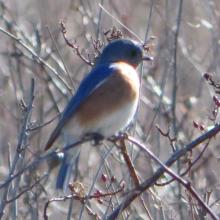Catharus guttatus
Common name:
Hermit thrush
Genus:
Catharus
Family:
Turdidae
Suborder:
-n/a-
Sialia sialis
Common name:
Eastern bluebird
Genus:
Sialia
Family:
Turdidae
Suborder:
-n/a-
Catharus guttatus
Common name:
Hermit thrush
Genus:
Catharus
Family:
Turdidae
Suborder:
-n/a-
Sialia sialis
Common name:
Eastern bluebird
Genus:
Sialia
Family:
Turdidae
Suborder:
-n/a-
Catharus guttatus
Common name:
Hermit thrush
Genus:
Catharus
Family:
Turdidae
Suborder:
-n/a-
Sialia sialis
Common name:
Eastern bluebird
Genus:
Sialia
Family:
Turdidae
Suborder:
-n/a-
Family-Animalia: Turdidae
The thrushes are a passerine bird family, Turdidae, with a worldwide distribution. The family was once much larger before biologists determined the subfamily Saxicolinae, which includes the chats and European robins, were Old World flycatchers. Thrushes are small to medium-sized ground living birds that feed on insects, other invertebrates and fruit. Some unrelated species around the world have been named after thrushes due to their similarity to birds in this family.
Characteristics
Thrushes are plump, soft-plumaged, small to medium-sized birds, inhabiting wooded areas, and often feeding on the ground. The smallest thrush may be the forest rock thrush, at 21 g (0.74 oz) and 14.5 cm (5.7 in). However, the shortwings, which have ambiguous alliances with both thrushes and Old World flycatchers, can be even smaller. The lesser shortwing averages 12 cm (4.7 in). The largest thrush is the blue whistling thrush, at 178 g (6.3 oz) and 33 cm (13 in). The great thrush is similar in length, but less heavily built. Most species are grey or brown in color, often with speckled underparts.
They are insectivorous, but most species also eat worms, land snails, and fruit. Many species are permanently resident in warm climates, while others migrate to higher latitudes during summer, often over considerable distances.
Thrushes build cup-shaped nests, sometimes lining them with mud. They lay two to five speckled eggs, sometimes laying two or more clutches per year. Both parents help in raising the young.[2] In almost all cases, the nest is placed on a branch; the only exceptions are the three species of bluebird, which nest in holes.
Reference: Wikipedia


